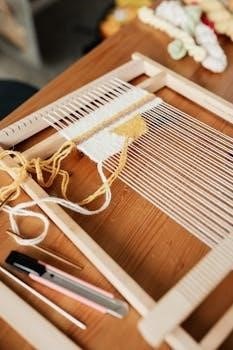Understanding UNF and UNC Thread Standards
Unified National Fine (UNF) and Unified National Coarse (UNC) threads are the most common types of Unified National threads․ They follow standards like ASTM B1;1, defining basic dimensions for design․ A thread chart PDF provides essential specifications, including threads per inch, major and minor diameters․
Unified National threads, commonly known as UN threads, are a standardized system for screw threads widely used in North America and beyond․ This system encompasses various thread series, with the most prevalent being UNC (Unified National Coarse) and UNF (Unified National Fine)․ These threads are defined by their geometry, pitch, and diameter, all of which are crucial for ensuring compatibility and proper fastening․ The Unified Thread Standard (UTS) provides a comprehensive framework for these threads, ensuring interchangeability and consistent performance․ The standard defines a basic profile, formula, and basic dimensions for both UNC and UNF threads․ These basic dimensions are nominal values, meaning they represent the ideal thread form without any allowances or tolerances․ However, for practical manufacturing and machining, it is essential to consider the allowable range for each dimension, as defined by the thread class․ The Unified National threads are characterized by a 60-degree thread angle, and their specifications are based on standard references, such as ASTM B1․1․ A PDF thread chart is an invaluable tool for accessing accurate and detailed specifications of these threads, including both UNC and UNF․ The chart typically provides information on the threads per inch (TPI), major and minor diameters, and the tap drill sizes for various thread sizes․ These charts are essential for designers, manufacturers, and engineers working with threaded fasteners, enabling them to select the correct threads for their applications․ They also help with ensuring proper fit and functionality when using screws, nuts, and other threaded components․ The thread charts can also include information on Unified Extra Fine (UNEF) threads, which are used for special applications․
Key Differences Between UNC and UNF
The primary distinction between UNC and UNF threads lies in their pitch, which is the distance between adjacent threads․ UNC threads, characterized as coarse threads, have a larger pitch, meaning fewer threads per inch compared to UNF threads․ This characteristic makes UNC threads more suitable for applications where faster assembly and disassembly are required, as well as for materials with lower tensile strength, where a greater thread engagement is beneficial․ In contrast, UNF threads, known as fine threads, have a smaller pitch, resulting in more threads per inch․ This provides a stronger and more precise connection, making them ideal for applications requiring higher strength and resistance to loosening due to vibration․ UNF threads also allow for finer adjustments and are often used in thin materials where a coarse thread might cause damage․ The difference in pitch also affects the tap drill sizes required for creating internal threads․ The tap drill sizes are smaller for UNF threads than UNC, reflecting the finer pitch․ A thread chart PDF will clearly display these differences, providing the exact pitch and tap drill size for each thread size in both series․ The choice between UNC and UNF depends on various factors, including material type, assembly requirements, and the desired strength and precision of the connection․ Engineers and designers rely on the information provided in thread charts to make informed decisions about the appropriate thread type for their specific applications․

Detailed Thread Chart Information
A comprehensive thread chart provides vital data for UNC and UNF threads․ This includes basic dimensions, like major and minor diameters, pitch, and threads per inch․ These measurements are crucial for design and manufacturing, ensuring proper fit and functionality․ A thread chart PDF offers this information․

Basic Dimensions for UNC Threads
UNC, or Unified National Coarse threads, are characterized by their larger pitch and fewer threads per inch compared to UNF threads․ The basic dimensions for UNC threads are fundamental for design purposes, representing the nominal sizes without allowances or tolerances․ These dimensions, often found in a thread chart PDF, include the major diameter, which is the largest diameter of the thread, and the minor diameter, representing the smallest diameter of the thread․ The pitch diameter, another essential measurement, is the diameter at which the thread width and the space between threads are equal․ For UNC threads, these dimensions are standardized, making them suitable for general-purpose fastening applications where high strength and quick assembly are priorities․ A thread chart will list these diameters for each UNC thread size, such as a 1/4-20 UNC thread, where 1/4 inch is the nominal major diameter, and 20 is the number of threads per inch․ These dimensions are crucial for engineers and machinists to accurately create mating parts․ For example, a 1-64 UNC thread has different basic dimensions compared to a 1/4-20 UNC, and a comprehensive chart outlines all these variations․ Always consult a reliable thread chart PDF for the exact values for your specific needs․
Basic Dimensions for UNF Threads
UNF, or Unified National Fine threads, feature a smaller pitch and more threads per inch compared to their UNC counterparts․ The basic dimensions for UNF threads, as outlined in a thread chart PDF, are essential for precision engineering․ These dimensions are nominal values, without accounting for tolerances, and are used for design purposes․ Key parameters include the major diameter, which is the largest diameter of the external thread, and the minor diameter, the smallest diameter of the internal thread․ The pitch diameter is another critical dimension, defined as the diameter where the thread width equals the space between threads․ UNF threads are favored in applications where greater tensile strength, finer adjustments, and higher resistance to loosening are required․ A typical thread chart PDF provides these basic dimensions for various UNF thread sizes․ For example, a 1/4-28 UNF thread has a major diameter of approximately 0․25 inches, and 28 threads per inch․ These dimensions differ from the 1/4-20 UNC, highlighting the difference between coarse and fine threads․ Utilizing a detailed thread chart PDF ensures that mating components are designed with the correct basic dimensions, leading to accurate and reliable assemblies․ Always verify your thread dimensions with a trusted thread chart․
Thread Pitch and TPI (Threads Per Inch)
Thread pitch and TPI, or Threads Per Inch, are fundamental concepts when discussing UNF and UNC threads, and are clearly detailed in any comprehensive thread chart PDF․ Pitch refers to the distance between adjacent threads, while TPI specifies the number of threads present within one inch of length․ For UNF threads, the pitch is smaller, resulting in a higher TPI compared to UNC threads of the same nominal diameter․ For instance, a 1/4-20 UNC thread has a pitch of 1/20th of an inch, or 20 TPI, while a 1/4-28 UNF thread has a pitch of 1/28th of an inch, or 28 TPI․ This difference in pitch and TPI directly impacts the mechanical properties and applications of the threads․ A higher TPI, as seen with UNF, offers better tensile strength and reduced likelihood of loosening under vibration․ The thread chart PDF usually lists the TPI directly alongside the thread size, making it easy to select the correct thread․ Understanding both pitch and TPI is crucial for choosing the right fasteners and ensuring accurate assembly․ Always consult a detailed thread chart PDF to confirm the correct TPI and pitch for your application․

Practical Applications and Usage
Understanding UNF and UNC threads is key in manufacturing and design․ The thread chart PDF aids in selecting the correct tap drill sizes․ UNC is used where quick assembly is needed; UNF offers better resistance to vibration in precise applications․
Tap Drill Sizes for UNC Threads
When working with UNC threads, selecting the correct tap drill size is crucial for successful threading․ The tap drill size refers to the diameter of the hole that must be drilled before a tap is used to create the internal threads․ A thread chart PDF will provide the specific tap drill size needed for each UNC thread․ For instance, a 1-64 UNC thread requires a drill size of 54, this is the drill bit size to use before tapping․ Using the correct tap drill size ensures the threads are formed properly, preventing issues like stripped threads or insufficient thread engagement․ The charts detail not only the drill size but also the basic major diameter, basic effective diameter, and basic minor diameters of external threads․ For example, for a 1/4-20 UNC thread, the chart will specify the necessary drill size, often around 7/32”, although it’s imperative to consult the chart for precise values․ The chart also includes TPI or Threads per inch․ Incorrect drill sizes can cause taps to break or result in loose or weak threads․ Always cross-reference with a reliable UNC thread chart PDF before tapping, this prevents errors during manufacturing or repair․ The charts often provide both imperial and metric equivalents for added convenience․ These tables are invaluable resources for engineers, machinists, and anyone involved in working with UNC threads․ They ensure accuracy and efficiency in the threading process․
Tap Drill Sizes for UNF Threads
Selecting the correct tap drill size for UNF threads is vital for creating accurate and functional internal threads․ Unlike UNC threads, UNF threads have a finer pitch, requiring different tap drill sizes․ A thread chart PDF is the most reliable resource to find these sizes․ For instance, a 0-80 UNF thread requires a 3/64 drill bit, while larger sizes demand larger drills․ The chart usually lists the drill size needed before tapping, alongside major and minor diameters․ Proper tap drill sizes ensure adequate thread engagement and prevent tap breakage․ A correctly sized hole allows the tap to cut threads without excessive stress or resistance․ If the drill hole is too small, the tap could break, while a hole that’s too large results in loose or weak threads․ The chart often includes basic major, effective, and minor diameters which further assist in precise thread creation․ For example, a 1/4-28 UNF thread will have a specific tap drill size, often close to 15/64″․ Always refer to the relevant chart PDF, as exact sizes vary․ Using these detailed charts, engineers and machinists can confidently create UNF threads without causing damage․ These charts are invaluable when designing and manufacturing parts, ensuring proper fit and function․ They also minimize trial and error, which saves both time and material․
Using the Chart for Design and Manufacturing
A comprehensive UNF and UNC thread chart PDF is an indispensable tool in both the design and manufacturing processes․ During the design phase, engineers consult these charts to select appropriate thread sizes based on load requirements and material properties․ This selection ensures that the threaded connections are robust and reliable, preventing failures in the final product․ The charts detail crucial dimensions like major diameter, pitch diameter, and minor diameter, allowing for accurate calculations and modeling․ In manufacturing, these charts guide machinists in selecting the correct tap drill sizes for internal threads and determining the appropriate outer diameter for external threads․ For example, when using a 1/4-20 UNC thread, the chart provides the precise tap drill size needed to create accurate internal threads, guaranteeing compatibility with mating parts․ The chart also aids in setting up machining equipment, ensuring that components are produced to required tolerances․ Furthermore, the thread chart assists in choosing the right tooling and measuring instruments․ By providing clear, detailed thread information, the PDF chart minimizes errors, reduces rework, and enhances the overall efficiency and quality of the manufacturing process․ It’s a crucial reference for ensuring that all threaded parts meet industry standards and perform as intended․

Additional Resources
For further understanding, access a comprehensive thread chart PDF, which provides detailed dimensions and tap drill sizes․ Additionally, it is important to understand thread class and tolerances․ These resources are vital for accurate design and manufacturing processes involving UNF and UNC threads․
Accessing a Comprehensive Thread Chart PDF
A comprehensive thread chart PDF is an indispensable resource for anyone working with UNF and UNC threads․ This readily accessible document provides a detailed overview of thread specifications, crucial for accurate design and manufacturing processes․ These PDFs typically include information not only on the basic dimensions, but also on the tolerances for various thread classes, ensuring precise fitting of components․ Within a thread chart PDF, you will find the key measurements like the major diameter, minor diameter, and pitch diameter, all clearly outlined for different thread sizes․ Furthermore, the thread chart PDF often specifies the threads per inch (TPI), which is essential for selecting the correct fastener for your application․ Many also include tap drill sizes, vital for creating internal threads that match the external ones accurately․ By using a thread chart PDF, engineers, machinists, and hobbyists can avoid guesswork and ensure the integrity and functionality of threaded connections․ These charts often include tables that are easy to read and reference, making the selection process straightforward․ They can also include diagrams that help visualize the thread profiles․ Having a reliable thread chart PDF at hand is essential for projects demanding precision and adherence to standards․ The PDF format allows for easy viewing on various devices, and ensures that data can be accessed anytime․ This availability helps to streamline the entire design and production process, saving time and minimizing errors․ These PDFs also often contain notes on special thread types and their uses, so having one on hand is essential․
Understanding Thread Class and Tolerances
Understanding thread class and tolerances is crucial for ensuring proper fit and function of threaded components․ The thread class defines the acceptable range of dimensional variations for a given thread, influencing how tightly two threaded parts will engage․ These classes are typically designated by a number, often followed by a letter, indicating the tightness of fit․ For example, classes like 2A and 2B are commonly used for general-purpose applications, offering a balance between ease of assembly and adequate strength․ The thread chart PDF often includes specific tolerance values for each thread class, allowing engineers to select the appropriate class for their design needs․ Tolerances are the permissible variations in dimensions such as major diameter, pitch diameter, and minor diameter․ These variations are necessary due to manufacturing limitations, and they are specified to ensure that parts will assemble correctly․ The thread chart PDF details these acceptable limits, so understanding them is essential for both design and manufacturing․ Tighter tolerances typically require more precise machining, leading to higher costs, but they are necessary for applications requiring a very accurate fit․ Conversely, looser tolerances may allow for easier and cheaper manufacturing, but they may not be suitable for high-precision applications․ The thread chart PDF, therefore, becomes invaluable for choosing the right balance between cost and performance․ It is crucial to look at the thread class, alongside the dimensions, to ensure a functional and reliable threaded connection․ The thread class and tolerance data are usually included in the same PDF as the dimensions data․